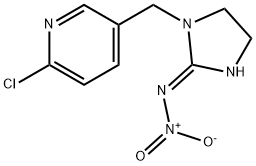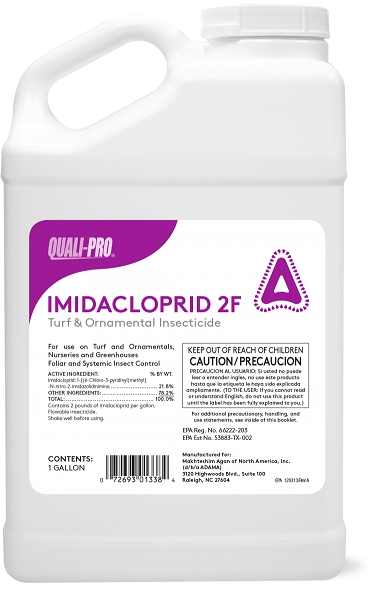Imidacloprid

- CAS No.
- 138261-41-3
- Chemical Name:
- Imidacloprid
- Synonyms
- Imidachloprid;midacloprid;neonicotinoids;Imidacloprid CRS;neonicotinoid;(E)-imidacloprid;Imidacloprid 97% TC;AMIRE;oprid;Grubex
- CBNumber:
- CB9730575
- Molecular Formula:
- C9H10ClN5O2
- Molecular Weight:
- 255.66
- MOL File:
- 138261-41-3.mol
- MSDS File:
- SDS
- Modify Date:
- 2024/8/4 20:11:12
| Melting point | 144°C |
|---|---|
| Boiling point | 93.5°C (rough estimate) |
| Density | 1.54 |
| vapor pressure | 2 x 10-7 |
| refractive index | 1.5790 (estimate) |
| Flash point | 2 °C |
| storage temp. | 0-6°C |
| solubility |
DMSO:75.5(Max Conc. mg/mL);295.31(Max Conc. mM) Ethanol:2.0(Max Conc. mg/mL);7.82(Max Conc. mM) Water:1.0(Max Conc. mg/mL);3.91(Max Conc. mM) |
| form | Solid |
| pka | 7.16±0.20(Predicted) |
| color | White to off-white |
| Water Solubility | 0.061 g/100mL at 20 ºC |
| LogP | 0.7 at 24℃ |
| CAS DataBase Reference | 138261-41-3(CAS DataBase Reference) |
| EPA Substance Registry System | Imidacloprid (138261-41-3) |
SAFETY
Risk and Safety Statements
| Symbol(GHS) |   GHS07,GHS09 |
|||||||||
|---|---|---|---|---|---|---|---|---|---|---|
| Signal word | Warning | |||||||||
| Hazard statements | H302-H410 | |||||||||
| Precautionary statements | P273-P301+P312+P330 | |||||||||
| Hazard Codes | N,Xn,F | |||||||||
| Risk Statements | 11-20/21/22-36-22-20/22 | |||||||||
| Safety Statements | 26-36-22-36/37-16-46-44 | |||||||||
| RIDADR | UN 2588 | |||||||||
| WGK Germany | 2 | |||||||||
| RTECS | NJ0560000 | |||||||||
| HazardClass | 6.1(b) | |||||||||
| PackingGroup | III | |||||||||
| HS Code | 29333990 | |||||||||
| NFPA 704 |
|
Imidacloprid price More Price(2)
| Manufacturer | Product number | Product description | CAS number | Packaging | Price | Updated | Buy |
|---|---|---|---|---|---|---|---|
| Sigma-Aldrich(India) | 46341 | Imidacloprid solution 100?μg/mL in acetonitrile, PESTANAL?, analytical standard | 138261-41-3 | 2ML | ₹6264.3 | 2022-06-14 | Buy |
| Sigma-Aldrich(India) | 37894 | Imidacloprid PESTANAL?, analytical standard | 138261-41-3 | 100MG | ₹7469.25 | 2022-06-14 | Buy |
Imidacloprid Chemical Properties,Uses,Production
Chemical Properties
Imidacloprid is a white solid crystal or powder under ambient conditions and have a low volatility (U.S. EPA, 2010; HSDB, 2006, 2012b).
History
Imidacloprid was discovered in 1984 at Nihon Bayer Agrochem in Japan by screening novel synthetic compounds for a high affinity to the insect nicotinic AChRs receptors, but with low toxicity to vertebrate species (Kagabu, 1997). Its molecule includes the insecticidal N-(3- pyridinyl)methyl group of nicotine and a nitroimine moiety. Because of their structural similarity to nicotine, imidacloprid and related insecticides (acetamiprid, thiacloprid, thiamethoxam and nitenpyram) were termed neonicotinoids (Tomizawa and Yamamoto, 1993). Nicotine possesses only modest insecticidal activity and is not stable for use in the field for crop protection. Imidacloprid has greater insecticidal activity than nicotine, and its stability is suitable for field use. Both the neonicotinoids and nicotinoids act as agonists at the nAChR. The principal differences between the two classes of compounds are that the nicotinoids are ionized at physiological pH and selective for the mammalian nAChR; whereas the neonicotinoids are not ionized and more selective for the insect nAChR. The selectivity of the neonicotinoids toward insects relative to mammals reflects the fundamental differences in the subunit combination and pharmacological profiles between the nAChR in insects and mammals (for review see Tomizawa and Casida, 2003).
Uses
Imidacloprid is the active ingredient in AdvantageTM used to control fleas in dogs and cats (HSDB, 2006). Clothianidin is the major metabolite of thiamethoxam and both compounds are registered for use as insecticides. Widespread use increased greatly in the 1990s as alternatives to organophosphosphorus and carbamate insecticides because of their much lower mammalian toxicity and resistance developed to other pesticides. Imidacloprid has become the most widespread insecticide used in the world.

A neonicotinoid; the active ingredient in certain neuro-active insecticides. Reports show that when exposed to neonicotinid pesticides honeybees have probelms returnign home after foraging and bumble bee colonies grow poorly and produce fewer queens.
Preparation
Reduction of 2-chloro-5-pyridinecarbonyl
chloride (8) to 2-chloro-5-hydroxymethylpyridine (9) was
carried out by excess NaBH4 in water, which was
converted to the chloride (10) by SOCl2
. Imidacloprid
was obtained by the coupling reaction of 10 with
2-nitroiminoimidazolidine (11) in acetonitrile with potassium
carbonate as base. This method was successfully
applied to the synthesis of [3H]imidacloprid (12)
using NaB[3H]4 as the tritium source (40).
Technical
production starts with the Tschitschibabin reaction of
3-methylpyridine giving 2-amino-5-methylpyridine (14),
which is transformed to the chloride (15) by the Sandmeyer
reaction in the presence of hydrogen chloride. A
successive operation of chlorination of the methyl group to
10 and the subsequent substitution of the active chloride
with ethylene diamine to 16 are carried out without isolation
of the intermediates. The final product is produced by ring formation with nitroguanidine. This multistep process
affords the product at a purity of >95% (41).
Definition
ChEBI: The E-isomer of imidacloprid.
Health Hazard
Imidacloprid is rapidly and almost completely absorbed (>92%) from the gastrointestinal tract of rats, and is eliminated from the organism rapidly and completely, with no indication of bioaccumulation of the parent compound or its metabolites (WHO, 2001). Similarly, thiamethoxam has relatively low solubility in nonpolar organic solvents and its octanol/water partition coefficient suggests that accumulation in fatty tissues is unlikely to occur (U.S. EPA, 2010).
Mechanism of action
Imidacloprid is a neurotoxic insecticide, which belongs to the class of the neonicotinoid pesticides. Imidacloprid is registered to control insect pests on agricultural and nursery crops, structural pests and parasites on companion animals.
Imidacloprid is an agonist of the nicotinic acetylcholine receptor (nAChR) at the neuronal and neuromuscular junctions in insects and vertebrates. It is structurally and functionally related to nicotine. The toxicity of imidacloprid is largely due to interference of the neurotransmission in the nicotinic cholinergic nervous system. Prolonged activation of the nAChR by imidacloprid causes desensitization and blocking of the receptor, and leads to incoordination, tremors, decreased activity, reduced body temperature and death. Presently, there is no specific antidote, which acts as an antagonist to the effects imidacloprid.
Pharmacology
Imidacloprid is a nitroguanidine compound and belongs to
the nitromethylene family of chemicals. Themode of action
of imidacloprid involves interference with neurological
transmission in insects by binding to the postsynaptic
nicotinic acetylcholine receptors. Imidacloprid is available
as a spot-on treatment for cats and dogs for flea control,
and, following application, it distributes throughout
the skin within 6 h (Bayer, 1996). It is not absorbed
systemically by the animal, and its adulticidal activity
is by contact with fleas.
Imidacloprid, besides its agricultural use,
is also used for the control of subterranean pests and pet
ectoparasites.
Pharmacokinetics
Imidacloprid is quickly absorbed by the oral route and rapidly distributed in nearly all organs and tissues. In rats, the oral absorption was estimated as 92-99%. Imidacloprid degrades to a large number of metabolites formed by multiple pathways. The same, or similar metabolites are found in rats, goats and hens. Based on structural considerations, the following metabolites may be of toxicological significance: 6-chloronicotinic acid, imidazolidine 4- and 5- hydroxy compounds, olefinic imidacloprid, desnitro-imidacloprid and the nitrosoimine compound. Metabolites were excreted primarily in the urine as glutathione and glycine conjugates of mercaptonicotinic acid and hippuric acid. Imidacloprid or its metabolites penetrated the blood-brain barrier. The parent compound and some of its metabolites have been detected in milk, meat of goats and hens, and eggs. Pharmacokinetic studies were not available for a direct determination of the rate of absorption from dermal and inhalation routes.
Metabolic pathway
The photolytic degradation of imidacloprid in different conditions yields diversified degradation products as indicated in the pathways. Photolysis in water gives 6- chloronicotinaldehyde, N-methylnicotinic acid amide, 1- (6-chloro-3-pyridinyl)methyl-2-imidazolinone and 6-chloro-3-pyridylmethylethylenediamine which are identified as main degradates together with a complex mixture of degradation products. On the surface of the tomato plant, four of the 14 metabolites are identified. In tobacco smoke, five degradates are detected, and in field soils, four metabolites are identified from the treated sugarbeet. As for the mammalian metabolites, the pathways are drawn tentatively by the author (see Klein145).
Metabolism
Acute oral LD50 for rats: ca. 450 mg/kg
Imidacloprid Preparation Products And Raw materials
Raw materials
1of2
chevron_rightPreparation Products
| Supplier | Tel | Country | ProdList | Advantage | Inquiry |
|---|---|---|---|---|---|
| CHEMAZON LABORATORIES | +91 9848551964 | Hyderabad, India | 1320 | 58 | Inquiry |
| Shogun Organics Ltd | +91-2266776846 +91-2266776845 | Maharashtra, India | 8 | 58 | Inquiry |
| Crop Life Science Limited | +91-7940373967 +91-7926872996 | Gujarat, India | 21 | 58 | Inquiry |
| Bharat Rasayan | +91-9619772584 +91-9619772584 | Maharashtra, India | 23 | 58 | Inquiry |
| Insecticides Ltd | +91-1127679700 +91-1127679700 | New Delhi, India | 13 | 58 | Inquiry |
| Kilpest India limited | +91-7552586536 +91-7552586536 | Madhya Pradesh, India | 38 | 58 | Inquiry |
| ENTOMIC CHEMICALS | +91-9425149263 +91-9425149263 | Madhya Pradesh, India | 39 | 58 | Inquiry |
| General Crop Science | +91-9810438260 +91-9896700555 | Haryana, India | 31 | 58 | Inquiry |
| SD Agro Chemicals | +91-9650182828 +91-9871331171 | Uttar Pradesh, India | 42 | 58 | Inquiry |
| Unique Farm Aid Pvt Ltd | +91-9873006591 +91-9873006592 | New Delhi, India | 31 | 58 | Inquiry |
| Supplier | Advantage |
|---|---|
| CHEMAZON LABORATORIES | 58 |
| Shogun Organics Ltd | 58 |
| Crop Life Science Limited | 58 |
| Bharat Rasayan | 58 |
| Insecticides Ltd | 58 |
| Kilpest India limited | 58 |
| ENTOMIC CHEMICALS | 58 |
| General Crop Science | 58 |
| SD Agro Chemicals | 58 |
| Unique Farm Aid Pvt Ltd | 58 |
138261-41-3(Imidacloprid)Related Search:
1of4
chevron_right




